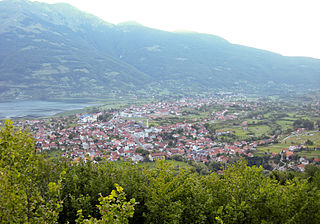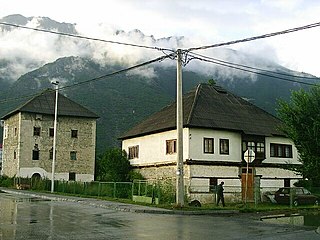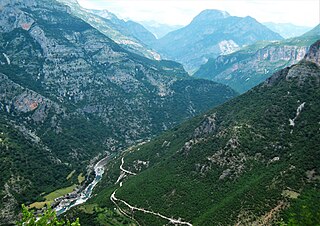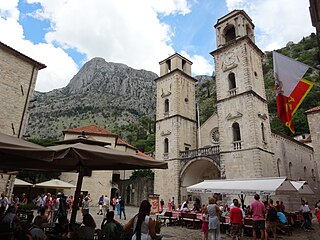
Malësia e Madhe, known simply as Malësia, is a historical and ethnographic region in northern Albania and eastern central Montenegro corresponding to the highlands of the geographical subdivision of the Malësi e Madhe District in Albania and Tuzi Municipality in Montenegro. The largest settlement in the area is the town of Tuzi.

Tuzi is a small town in Montenegro and the seat of Tuzi Municipality, Montenegro. It is located along a main road between the city of Podgorica and the Albanian border crossing, just a few kilometers north of Lake Skadar. The Church of St. Anthony and Qazimbeg's Mosque are located in the centre of the town. Tuzi is the newest municipality in Montenegro, having been an independent municipality since 1 September 2018.

Plav is a town in Polimlje region in north-eastern Montenegro. It has a population of 3,717. Plav is the centre of Plav Municipality.

Gusinje is a small town in Polimlje region in north-eastern Montenegro. According to the 2011 census, the town has a population of 1,673 and is the administrative center of Gusinje Municipality.

Dedë Gjon Luli Dedvukaj also referred to as Ded Gjo Luli and Deda was an Albanian guerrilla leader most notable for commanding the 1911 revolt against Ottoman troops. He was posthumously awarded the "Hero of Albania" title. Dedvukaj was the clan chieftain of the Hoti tribe.

The Cem, also known as the Cijevna, is a river that rises in Kelmend, Albania and after nearly half of its length crosses into Montenegro, where it flows into the River Morača near the capital Podgorica.
Albanians in Montenegro are an ethnic group in Montenegro of Albanian descent, which constitute 4.91% of Montenegro's total population. They are the largest non-Slavic ethnic group in Montenegro.

Kelmendi is a historical Albanian tribe (fis) and region in Malësia and eastern Montenegro. It is located in the upper valley of the Cem river and its tributaries in the Accursed Mountains range of the Dinaric Alps. The Vermosh river springs in the village of the same name, which is Albania's northernmost village. Vermosh pours into Lake Plav.

The Catholic Church in Montenegro is part of the worldwide Catholic Church, under the spiritual leadership of the Pope in Rome.

Hoti is a historical Albanian tribe (fis) and sub-region of Malësia, a divided area located in northern Albania and southern Montenegro. Its geography is mostly mountainous, but some of its villages are on flat terrain near the banks of Lake of Shkodër.

Gruda is a Northern Albanian tribe and historical tribal region in southeastern Montenegro, just north of Lake Skadar, which includes the small town of Tuzi, in Podgorica. It is inhabited by a majority of ethnic Albanians.

The Battle of Deçiq was a battle between Albanian tribesmen and Ottoman forces during the Malësori uprising of 1911. It was a turning point for Albania's secession from the Ottoman Empire. Dedë Gjo Luli, the organiser of the Albanian tribal forces, raised the Albanian flag for the first time since 1479 on the mountain of Deçiq after the Albanians had achieved victory over the Ottoman Turks.

The Sanjak of Scutari or Sanjak of Shkodra was one of the sanjaks of the Ottoman Empire. It was established after the Ottoman Empire acquired Shkodra after the siege of Shkodra in 1478–9. It was part of the Eyalet of Rumelia until 1867, when it became a part, together with the Sanjak of Skopje, of the newly established Scutari Vilayet. In 1912 and the beginning of 1913 it was occupied by members of the Balkan League during the First Balkan War. In 1914 the territory of Sanjak of Scutari became a part of the Principality of Albania, established on the basis of the peace contract signed during the London Conference in 1913.

Kastrati is a historical Albanian tribe (fis) and region in northwestern Albania. It is part of the Malësia region. Administratively, the region is located in the Malësi e Madhe District, part of the Kastrati municipal unit. The centre of Kastrati is the village of Bajzë. The Kastrati tribe is known to follow the Kanuni i Malësisë së Madhë, a variant of the Kanun. They are proverbally known for their pride - Kastrati Krenar.

The Albanian tribes form a historical mode of social organization (farefisní) in Albania and the southwestern Balkans characterized by a common culture, often common patrilineal kinship ties tracing back to one progenitor and shared social ties. The fis stands at the center of Albanian organization based on kinship relations, a concept that can be found among southern Albanians also with the term farë.

Gusinje Municipality is a municipality in eastern Montenegro in the upper Lim valley at an elevation of about 1,000 m (3,000 ft). It was created in 2014, when it split from Plav Municipality. Its center is the small town of Gusinje, and its biggest village in terms of territory is Vusanje. Two of Montenegro's highest mountains overlook Gusinje: Zla Kolata and Visitor. Many of Gusinje's settlements are historically linked with the Albanian Kelmendi tribe (fis). The village of Gusinje developed into a town the 17th century around a fortress built by the Ottomans to contain the Kelmendi. In the 19th century, Gusinje was a developing regional market center. It was engulfed in 1879–1880 in a struggle between the Principality of Montenegro that wanted to annex it and the League of Prizren that opposed it. After the Balkan Wars, Gusinje became part of Montenegro and in 1919 part of Yugoslavia. Today, it is part of Montenegro since its declaration of independence in 2006.

Trieshi is a historical Albanian tribe (fis) and region in Montenegro above the right bank of the Cem river near the Albanian border in Tuzi Municipality. It is part of the region of Malësia.

Mataguzi was an Albanian tribe in the Middle Ages in southern Montenegro, on the northern shores of Lake Skadar. Their area of settlement included the modern village of Mataguži which takes its name from the tribe.
Dosuđe is a village in the municipality of Gusinje, Montenegro.
Vuksanlekići is a village in the municipality of Tuzi, Montenegro.












